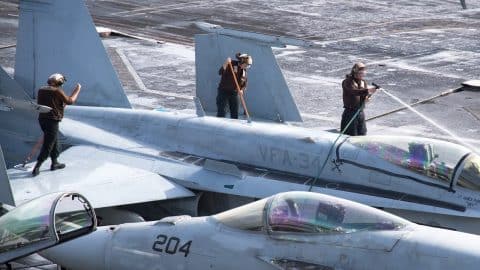
YouTube / Not What You Think
Naval deployments usually come with rigorous demands, which places significant stress on military aircraft aboard carriers.
Corrosion, if left unchecked, can lead to extensive damage, necessitating expensive repairs or even premature replacement of vital aircraft components.

By washing the planes regularly, the accumulation of corrosive substances is minimized, extending the lifespan of the aircraft. This proactive maintenance practice not only saves costs in the long run but also allows resources to be allocated to other critical areas.
Automated washing robots are slowly making their way into the military. The US Air Force has developed a robot that can wash an F-16 Fighting Falcon in under an hour – and it only needs one man behind a laptop. In most cases, washing an F-16 would take a team of four ground crews six hours to finish.

Not only does this robot save plenty of man-hours, but it also limits the exposure of ground personnel to toxic chemicals while also reducing the downtime of freshly-cleaned aircraft from 2 days to now just 1.
But what about washing planes on aircraft carriers?
Fresh water is a luxury when you’re deployed in the middle of the ocean. Even though a Nimitz-class carrier can distill about 400,000 gallons of fresh water every day, most of it is used to generate steam for the catapults and power other features found aboard the carrier.

And due to the salty environment that these planes are placed in, the typical cleaning interval can range from 7 to 14 days. Of course, this interval depends on several factors, such as intensity of operations, weather conditions, and availability of resources.